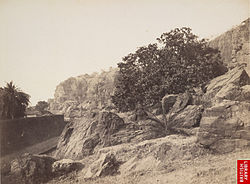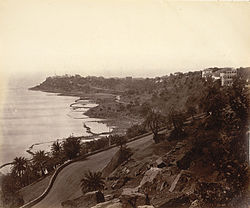Malabar Hill | |
|---|---|
Neighbourhood | |
 Malabar Hill in the 1850s | |
| Coordinates: 18°57′00″N72°47′42″E / 18.95°N 72.795°E | |
| Country | India |
| State | Maharashtra |
| District | Mumbai City |
| City | Mumbai |
| Government | |
| • Type | Municipal Corporation |
| • Body | Brihanmumbai Municipal Corporation (MCGM) |
| Languages | |
| • Official | Marathi |
| Time zone | UTC+5:30 (IST) |
| PIN | 400006 [1] |
| Area code | 022 |
| Vehicle registration | MH 01 |
| Civic agency | BMC |
Malabar Hill is amongst the most affluent residential areas in Mumbai. [2] It is home to several business tycoons and film personalities. Muhammad Ali Jinnah, the founder of Pakistan, had built and lived in a bungalow, called South Court, in Malabar Hill.
Contents
Prominent landmarks include the South Court mansion of the Jinnah family, the Chief Minister of Maharashtra's Varsha Bungalow, Government Guest House Sahyadri, official residences of VVIP state officials and additionally the Hanging Gardens, Jain Temple and Banganga Tank. Other notable residents include Radhakishan Damani [3] and Syedna Mufaddal Saifuddin.















